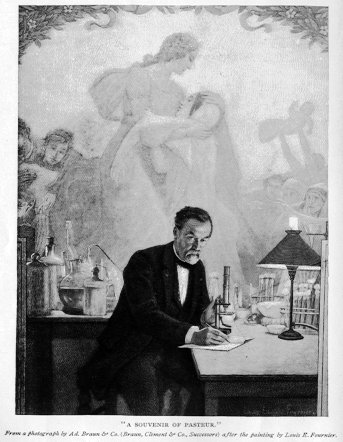Today, Louis Pasteur is prepared to see a mirror image. The University of Houston's College of Engineering presents this series about the machines that make our civilization run, and the people whose ingenuity created them.
We remember Louis Pasteur for showing us how to kill germs in milk. Long before that, he did something else which, by itself, would've made him one of the greats in chemistry.
When he was 25, Pasteur became puzzled by two salts with peculiar optical properties. A solution of tartaric acid in water bent polarized light. But racemic acid had exactly the same chemical makeup as tartaric acid. And his racemic acid solution did nothing at all to polarized light.
Pasteur pored over the two salts -- supposedly identical. He picked at the racemic acid crystals. Then, suddenly, he saw it! There were two kinds of crystals. One looked the same as tartaric acid. The other was its mirror image.
He separated the crystals into two piles. Then he made solutions of each. When he shone polarized light through them, one bent the light clockwise, the other bent it counterclockwise.
The process he'd used to make tartaric acid had left all its crystals right-handed. But both kinds of crystals turned up in his racemic acid. They canceled each other out.
The molecular structure of the salts had a mirror image. Just as you can't use a right glove on your left hand, you couldn't rotate one shape into the other. The same arrangement of the same atoms gave two different molecules. Chemists call this property "chirality." It comes from the Greek word for hand.
When the young Pasteur announced his discovery, an aging Jean Baptiste Biot showed up from the French Academy of Science. "Show me!" he demanded. Together, Pasteur and Biot ran the experiment. When it worked, Biot seized Pasteur's hand and, in a voice charged with emotion, said, "I have loved science so much during my life, that this touches my very heart."
Of course the discovery reached far beyond those salts. The fact that some molecules can be left or right-handed helps set the complex rules of chemical structure.
Chance played its part in Pasteur's discovery. He'd prepared his racemic acid on a cool window sill. In a warmer climate that process wouldn't have given him both left and right-handed molecules. That only happens below 79° F.
Pasteur himself said something very important about that. It was, " ... chance favors only the prepared mind."
We've said before in this series that invention is a form of recognition. It is seeing a thing out of context. Pasteur changed chemistry just because his mind was prepared to receive an unexpected idea.
I'm John Lienhard, at the University of Houston, where we're interested in the way inventive minds work.
(Theme music)
Roberts, R.M., Serendipity: Accidental Discoveries in Science. New York: John Wiley & Sons, Inc., 1989, Chapter 12.
Kempe, D.S. and Vellaccio, F., Organic Chemistry. New York: Worth, 1980, pp. 172-173.
Roberts adds a sobering note about chirality. Thalidomide, which created so many birth defects in the 1950s, is chiral. One form is a harmless morning-sickness suppressant. The mirror image is an active mutagen. The drug was put on the market with both forms present, and it did untold damage.
For more on chiral molecules, see Episode 1181.

Picture of Pasteur from Munsey's Magazine, May 1897